Introduction
Imperforate hymen is at the extreme of a spectrum of variations in hymenal configuration. Variations in the embryologic development of the hymen are common and result in fenestrations, septa, bands, microperforations, anterior displacement, and differences in rigidity and/or elasticity of the hymenal tissue. Inspection of the external genitalia and anus are important components of the physical examination of the female neonate and child. While this examination can and should be accomplished by the pediatrician, the observant delivering obstetrician can learn much about the normal variations in genital configuration by examining the female neonate in the delivery room, keeping in mind the influence and structural changes induced by maternal estrogens. Under this influence, the labia majora are plump, the hymen is elastic and often fimbriated, and the mucosal surfaces (ie, introitus, fossa navicularis, vaginal vestibule) are pale pink.Problem
Imperforate hymen has been diagnosed with prenatal ultrasound documentation of bladder outlet obstruction due to hydrocolpos or mucocolpos. However, in spite of the recommendations for inspection of the external genitalia during the neonatal and early childhood period, variations in hymenal anatomy commonly escape diagnosis until the time of menarche.Different normal variants in hymenal configuration are described, varying from the common annular, to crescentic, to navicular ("boatlike" with an anteriorly displaced hymenal orifice). Hymenal variations are rarely clinically significant before menarche. In the case of a navicular configuration, urinary complaints (eg, dribbling, retention, urinary tract infections) may result. Sometimes, a cribiform (fenestrated), septate, or navicular configuration to the hymen can be associated with retention of vaginal secretions and prolongation of the common condition of a mixed bacterial vulvovaginitis.
Occasionally, a hymenal tag will protrude from the vaginal vestibule, leading to concerns about a tumor or other significant pathology. These hymenal tags are of no clinical significance, and they do not require therapy if vaginal origin can be excluded based on findings from a careful examination.
Imperforate hymen in infancy or childhood
On occasion, an infant or young child may be thought to have an imperforate hymen. However, after the neonatal period, when maternal estrogen levels have declined, examination of the area may be challenging. Careful examination with pressure applied to the fourchette may reveal microperforations, sometimes with an anteriorly displaced opening just beneath the urethra. Capraro described a surgical technique similar to a perineotomy to correct such a defect; however, in asymptomatic patients, waiting until puberty is generally recommended before deciding whether such a technique is necessary.
The hymenal changes that result from estrogenization (increased elasticity and fimbriation) may reveal the hymen to be open and obviate the need for surgery. In addition, surgical procedures to the vagina and hymen during childhood, when endogenous estrogen levels are low, may result in scarring and the need for subsequent surgical revision. Thus, surgery during this time should generally be avoided if possible. If the hymen is suspected to be imperforate during childhood, re-examination should be performed after the onset of breast development, signaling the production of estrogen. If required, surgery can be performed at a time when healing is optimal and prior to the accumulation of a hematocolpos.
In a review of 23 cases of imperforate hymen, Posner et al emphasizes the ease of making a diagnosis of imperforate hymen by routine genital examinations in childhood. The authors compared the significant delays and difficulties in making the diagnosis after the onset of puberty, primarily because the diagnosis was not considered, with the simplicity of making the diagnosis in asymptomatic prepubertal children by a simple genital examination.1
Sexual abuse
Accurate description of the morphology and integrity of the hymen is critical in the diagnosis of female sexual abuse. Imperforate hymen has been described as occurring as a result of scarring from penetration and abuse, thus emphasizing the importance of an early examination to document the congenital, rather than acquired, etiology.2 Concerns about hymenal disruption and lacerations associated with sexual abuse with digital or penile penetration have led to discussions of the normal hymenal diameter.
Historically, the diameter of the hymenal opening (measured within the hymenal ring) was proposed to be approximately 1 mm for each year of age. Clearly, this guideline does not apply in the neonatal stage, when maternal estrogens lead to an elastic hymen; however, in the prepubertal stage, marked enlargement, according to this guideline, should prompt consideration of the possibility of abuse. An important difficulty with this generalized rule is that the degree of the child's relaxation and comfort with both the examination and the examiner clearly affects measurements, as does the type of measuring device used. While the possibility of abuse should be considered, these size guidelines should be used with caution during an evaluation.
Experts in sexual abuse assessment have used unaided visual examination and colposcopy to examine the integrity of the hymenal ring. Lacerations through the hymen into the fossa navicularis and introitus suggest a penetrating injury. Frequently, sexual abuse evaluations are conducted at some time remote from the immediate injury; thus, healed or healing lacerations are noted.
Muram concluded that the use of the colposcope by an experienced examiner adds little to an evaluation by an experienced colposcopist with expertise in abuse. In addition, Muram proposed a scale that the examiner can use to evaluate physical findings as normal, abnormal and nonspecific, abnormal and suggestive of abuse, and definitive for abuse. That last category includes only the situation in which sperm are found during the examination.3 Additional aids to the examination of the hymen have been described, including the trick of inserting a Foley catheter into the vagina and inflating the balloon behind the hymen to stretch the hymenal margin and allow for a better examination.4
Anatomic anomalies
Consider anatomic anomalies that can be confused with imperforate hymen in the differential diagnosis. These anomalies include the following:
- Acquired labial adhesions (see image below)
- Obstructing or partially obstructing vaginal septa (longitudinal or transverse)
- Vaginal cyst
- Vaginal agenesis (Mayer-Rokitansky-Kuster-Hauser syndrome) with or without the presence of a uterus or functional endometrium (see image below)
- Complete androgen insensitivity syndrome (testicular feminization)
Frequency
Imperforate hymen is likely the most frequent obstructive anomaly of the female genital tract, but estimates of its frequency vary from 1 case per 1000 population to 1 case per 10,000 population. Heger et al examined 147 premenarchal girls with a mean age of 63 months to collect normative data on genital anatomy; an imperforate hymen was found in only one patient (<1%) and hymenal septa were found in 3 (2%).5Imperforate hymen usually occurs sporadically, but a handful of cases have been reported to be familial.6,7 Examination of first-degree relatives/female siblings of affected individuals has been recommended.
Etiology
Imperforate hymen and related genital tract anomalies result from abnormal or incomplete embryologic development.Pathophysiology
The genital tract develops during embryogenesis, from 3 weeks' gestation to the second trimester. The initial development of both the male and female genital tracts is identical and is referred to as the indifferent stage of development.- Paired wolffian (mesonephric) ducts connect the mesonephric kidney to the cloaca. The metanephric or true kidney derives from the ureteric bud (arising from the mesonephric duct) at about the fifth embryonic week.
- The paramesonephric or müllerian ducts can be identified during the sixth week of embryologic development and lie lateral to the wolffian ducts until they reach the caudal end of the mesonephros, where they come toward the midline.
- During the seventh week, the urorectal septum forms to separate the rectum from the urogenital sinus.
- By the ninth week, the müllerian ducts move caudally to reach the urogenital sinus, forming the uterovaginal canal and inserting into the urogenital sinus.
Gonadal development
The development of the gonads occurs from the migration of primordial germ cells to the genital ridge, while the genital tract itself develops from the müllerian ducts (paramesonephric ducts), urogenital sinus, and vaginal plate. Thus, anomalies of the vagina, hymen, and uterus are not accompanied by abnormalities of ovarian development, and hormonal and endocrinologic function is without abnormality, leading to expected pubertal breast and pubic hair development.
Because the mesodermal layer contributes to the development of the kidneys, gonads, and ductal structures, defects or insults in embryologic development may result in congenital defects of the kidneys that accompany abnormalities of the vagina and uterus.
The lining of the urethra and urinary bladder derives from endoderm, and the urogenital sinus forms the urethra and vestibule in females. The ectoderm fuses with the endoderm to contribute to the patency and canalization of the genital tract. Defects in this process lead to fusion failures and imperforate and obstruction defects.
Familial occurrence
Familial occurrence, although rare, is reported and screening by history or examination of family members is warranted.7 Dominant transmission (either sex-linked or autosomal) and sibships suggesting a recessive mode of inheritance are described.8 The inheritance of müllerian defects likely is polygenic or multifactorial, although some syndromes of heritable disorders are described with associated genital and nongenital anomalies.
Anomalies of the female reproductive tract
Anomalies of the female reproductive tract can result from agenesis or hypoplasia, vertical fusion and/or canalization defects, lateral fusion and/or duplication abnormalities, or failure of resorption, resulting in septa. Recent reports have noted the concurrent presence of lateral fusion defects with imperforate hymen.9
Presentation
Prenatal diagnosisRarely, diagnosis of imperforate hymen in the fetus has been made with obstetric ultrasonography. In such cases, the anomaly is visible on the imaging study because of hydrocolpos, hydrometrocolpos, or mucocolpos.10,11
Diagnosis in infancy or childhood The diagnosis is infrequently made during infancy in the neonatal nursery. The infant may have a bulging, yellow-gray mass at or beyond the introitus. Several case reports describe the presence of an abdominal mass in association with urinary obstruction.
Ultrasonography is an essential first step in diagnosis, precluding unwise and unplanned surgical intervention with resultant injury to the urethra or other pelvic structures, and excluding other more complicated anomalies.
Routine examination of the female genitalia by primary care clinicians during childhood is strongly recommended so that genital abnormalities can be diagnosed early. Observation throughout childhood, with a planned hymenotomy after the onset of puberty is a reasonable course of action in most cases diagnosed in infancy or childhood, assuming no urinary symptoms or obstruction is present. Surgery in the presence of adequate estrogenization avoids scarring and the potential need for a repeat surgery that can occur when surgery is performed on the unestrogenized hymen and vagina.
If the diagnosis is equivocal (ie, imperforate hymen vs labial adhesions vs late-onset congenital adrenal hyperplasia), referral to a pediatric gynecologist may be warranted. Typically, a mucocele is not present even if the condition is noted at birth. If a patient is diagnosed with an asymptomatic imperforate hymen in infancy or childhood beyond the neonatal period, the optimal time for surgical repair is after the onset of puberty and prior to menarche.
Diagnosis and surgical repair in adolescence
Diagnosis depends on an awareness of the condition as a possible anomaly, and surveillance with well-child care. When the condition presents as abdominal pain or an abdominal mass (see image below), diagnostic testing is often extensive because the condition is not considered.1 An abdominal mass may prompt the consideration of an ovarian tumor and tumor markers may be obtained. While a false-positive elevation of CA-125 in premenopausal women has numerous causes, and testing has thus been discouraged, elevated CA-125 and 19.9 have been described with imperforate hymen, and may delay the diagnosis.12,13
Surgical repair after the onset of puberty but before menarche is optimal. The most common scenario is that in which a young woman presents with increasingly severe intermittent abdominal and pelvic pain due to a large hematocolpos and hematometra.
Walsh and Shih present a case of a 14-year-old elite athlete who presented to the emergency department and her pediatrician on multiple occasions over the course of several months with symptoms of cyclic abdominal pain, urinary retention, and constipation due to hematocolpos and hematometra.14 This is an all too common presentation. In this reported case, even after placement of a Foley catheter for urinary retention on 2 separate occasions, the diagnosis of imperforate hymen was missed.
While these young adolescents typically present to an emergency department with relatively acute pain, this condition should generally not be managed as an acute emergency. Defining the anatomy with appropriate imaging techniques and arranging for the most skilled and experienced gynecologist to perform surgery on a scheduled rather than emergent basis, is essential.
Urinary pressure and even retention with hydroureter and/or hydronephrosis may occur due to the mass effect and resultant obstruction. Frequently, vaginal and rectal pressure is present. Severe constipation and low-back pain are described as presenting symptoms. The laborlike menstrual cramps may be severe and cyclic, although the cyclic nature of the symptoms may not be easily or immediately noticed by the young woman or her family.
Unfortunately, the typical findings at diagnosis may include a large collection of blood within the uterus (hematometra) and an even larger collection of blood within the distensible vagina (hematocolpos). Additional findings may include blood-filled fallopian tubes (hematosalpinges) and signs of retrograde menses, occasionally to the point of the development of intra-abdominal endometriosis and severe pelvic adhesions. The classic teaching is that endometriosis associated with obstructive anomalies resolves spontaneously and does not cause problems with subsequent pain and infertility compared with endometriosis arising spontaneously; however, this assertion is anecdotal rather than evidence based.
Clinically, families are often concerned about whether the ovaries are normal when vaginal or hymenal anomalies are present; the course of separate embryologic development allows assurance of normal hormonal function without any need for hormonal testing or ovarian imaging. The exception to this is the diagnosis of androgen insensitivity syndrome with XY chromosomal complement in which the gonads require removal to prevent malignant transformation.
Differential diagnosis The differential diagnosis of an imperforate hymen includes many conditions, some rare and others relatively common. Absolute confirmation of the diagnosis of an imperforate hymen is imperative prior to any attempted surgical repair in order to prevent vaginal scarring that can occur if a thick vaginal septum is inadvertently confused with a thin imperforate hymen.
- Labial adhesions
- The presence of acquired labial adhesions in a prepubertal girl is a common situation that is often confused with absence of the vagina. Labial adhesions, sometimes incorrectly termed vaginal adhesions, are not congenital and result from labial agglutination most commonly due to inflammation. Small areas of labial adhesions can be managed expectantly. Extensive labial adhesions or those associated with such symptoms as recurrent urinary tract infections, urinary dribbling, or recurrent vulvovaginitis can be managed easily using the topical application of estrogen cream for 2-6 weeks. Such treatment results in marked thinning of the adhesions, often with spontaneous resolution.
- Separation of thick adhesions is possible in an office setting with a child who can be restrained; however, this procedure ultimately is counterproductive because the examination frequently is difficult and traumatic, resulting in the subsequent inability to adequately examine the genital area due to the child's refusal because of memories of pain. Such traumatic lysis should be avoided. General anesthesia in an operative setting may thus be required.
- Management of labial adhesions can be problematic as recurrence is common. Parents or caretakers must be instructed on how to ensure the child maintains excellent perineal hygiene and avoids vulvovaginitis. The daily application of a topical emollient (such as A&D ointment) helps reduce the risk of recurrence until endogenous pubertal estrogen stimulation alleviates the risk. Thus, the application of a topical emollient should be continued until the child shows signs of estrogen-stimulated breast development.
- Rarely, an adopted child will be found to have what appears to be labial adhesions, and these may be suggestive of female genital mutilation that occurred at a young age. The thick adhesions that result from this trauma may require surgical separation and management by a gynecologist with experience in managing female genital mutilation.
- Labial adhesions may be confused with posterior labial fusion encountered in persons with congenital adrenal hyperplasia and may be differentiated by careful physical examination with attention to the presence or absence of clitoromegaly.
- The differential diagnosis for a cystic mass at the hymen includes ectopic ureter, hymenal cyst, hymenal skin tag, periurethral cyst, and vaginal cyst.15
- Incomplete hymenal obstruction
- In the case of incomplete hymenal obstruction due to a cribiform hymen or hymenal band, the typical presenting symptom is difficulty inserting a tampon or even the inability to achieve vaginal intercourse in an adolescent. Anatomic variations must be distinguished from involuntary vaginismus or contraction of the perineal and pelvic musculature or levator ani muscles, which can be associated with the learning process of tampon insertion, becoming a vicious cycle when persistent insertion is attempted without success and causes pain.
- Hymenotomy occasionally may be indicated in the case of a rigid inelastic hymen, particularly for young female athletes (eg, swimmers, divers, gymnasts, cheerleaders) who may be hypoestrogenic, leading to the rigid hymenal configuration. As athletes, these girls are often eager to use tampons. A reasonable alternative to surgical correction involves the use of progressive dilation in a motivated young woman, along with topical estrogen. In these athletes with a rigid hymen, an evaluation for hypoestrogenism associated with overly vigorous physical activity should be considered; if present, estrogen replacement improves the hymenal characteristics and increases hymenal elasticity.
- Hymenal bands: This condition is typically amenable to division using a local anesthetic in the office; however, the young woman's age and tolerance of such an office procedure must be predicted and judged. Her degree of motivation for tampon use or intercourse impacts the timing at which she requests such a procedure. A typical presenting history of an individual with a hymenal band is the ability to insert a tampon but extreme difficulty removing it. The author has encountered a patient in whom the tampon string became wrapped around the hymenal band, leading to marked edema and pain when removal was attempted.
- Obstructing longitudinal or transverse septa: These conditions require careful preoperative evaluation to define the anatomy prior to any attempted surgical reconstruction. The repair of such complicated anomalies should usually be referred to a gynecologist at a tertiary care center where these cases are not a rarity. MRI is the optimal imaging modality for defining complicated female reproductive anatomy.16
- Vaginal agenesis or androgen insensitivity: The evaluation and management of vaginal agenesis or androgen insensitivity syndrome is beyond the scope of this article, but these conditions should be considered in the differential diagnosis.
- Androgen insensitivity is diagnosed based on findings of a blind vaginal pouch, with an XY chromosomal complement. Mayer-Rokitansky-Kuster-Hauser syndrome (uterovaginal agenesis) may include uterine remnants, some containing endometrium as well as myometrium. These patients should be referred to a gynecologist who specializes in adolescents and who has experience in managing these conditions.
- The options for creation of a neovagina are operative, such as a McIndoe, Davydov, Vecchietti or Williams procedure, or nonoperative, using progressively larger Lucite dilators. The condition can usually be managed nonsurgically, which minimizes the potential for scarring and has high rates of success.17
- The presentation of an abdominal mass must be differentiated from urinary obstruction or tumors such as sacrococcygeal teratoma with abdominal extension, ovarian tumor, or other masses like mesenteric cysts or anterior meningoceles.15
Indications
An imperforate hymen at the time of puberty must be corrected surgically. The surgical decision-making process should focus on appropriate diagnosis and timing of surgical repair. While the patient may present with acute pain, the repair should not be performed emergently without carefully defining the anatomy. The surgery should be performed by a gynecologist who is skilled and experienced in the care of adolescents with genital anomalies.Relevant Anatomy
An imperforate hymen presenting after the onset of menstrual shedding is visible upon examination as a translucent thin membrane just inferior to the urethral meatus that bulges with the Valsalva maneuver. This bluish discoloration is due to the presence of a hematocolpos visible behind the translucent hymenal membrane. Vaginal septa do not typically appear translucent.Depending on the size and volume of the hematometra, hematocolpos, or hematosalpinges, a pelvic or abdominal mass may be palpable during abdominal or rectal examination.
Radiographic documentation must demonstrate that the true diagnosis is not an obstructing transverse vaginal septum or other anomaly. Pelvic ultrasonography via the transabdominal, transperineal, or transrectal route is indicated as the initial diagnostic test, followed by MRI if any questions remain about the anatomy. Transperineal ultrasonography can be helpful in measuring the thickness of the septum. Because renal and urologic abnormalities are associated with müllerian abnormalities, imaging of the upper urinary tract can help diagnose ipsilateral renal agenesis, duplex collecting systems, and other complex renal anomalies.The prevalence of renal agenesis is estimated at 1 case per 600-1200 persons on the basis of autopsy studies. As many as 25-90% of women with renal anomalies are suggested to have concurrent genital anomalies; thus, abdominal and pelvic imaging of these patients is also warranted.
 Unknown
Unknown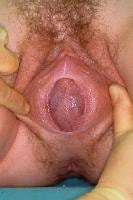
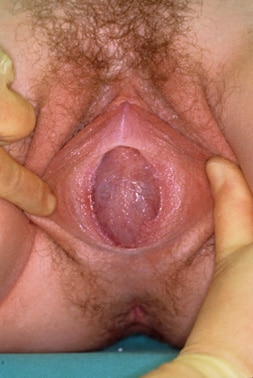
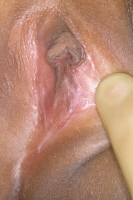
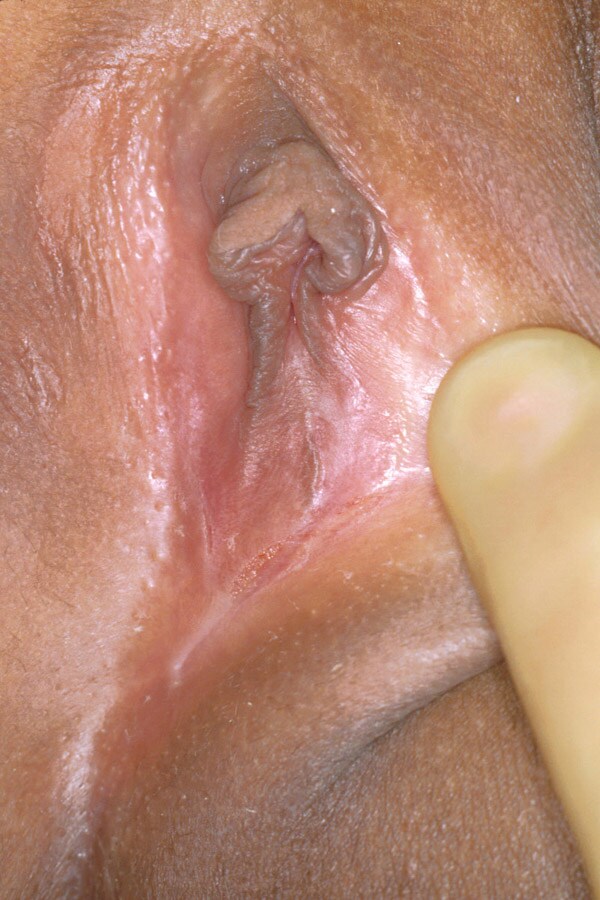
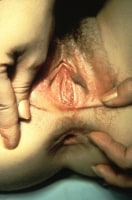
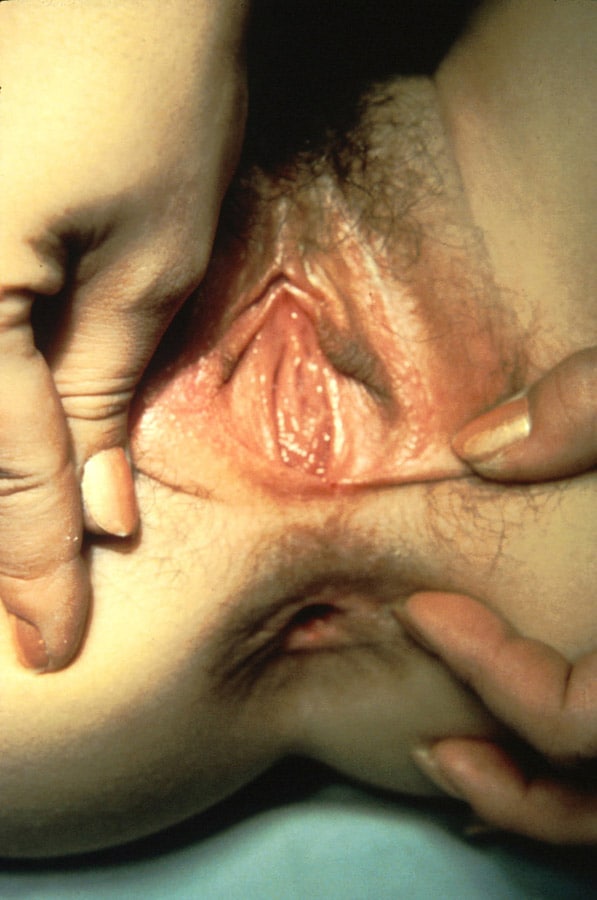

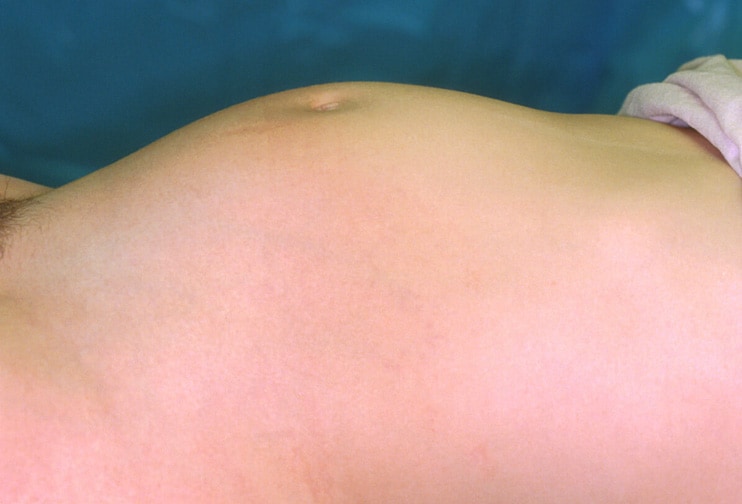









0 komentar:
Post a Comment